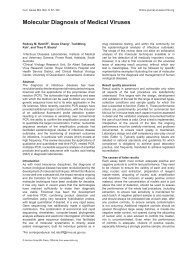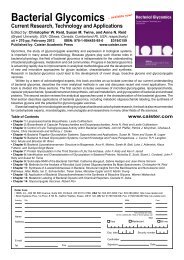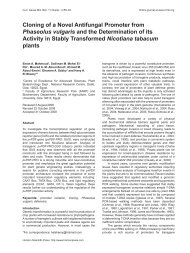Molecular Diagnostics of Medically Important Bacterial Infections
Molecular Diagnostics of Medically Important Bacterial Infections
Molecular Diagnostics of Medically Important Bacterial Infections
Create successful ePaper yourself
Turn your PDF publications into a flip-book with our unique Google optimized e-Paper software.
30 Millar et al.<br />
survival in patients with cystic fibrosis (CF) (Høiby<br />
1991). Certain members <strong>of</strong> the BCC are transmissible<br />
and epidemics have been described in a number <strong>of</strong> CF<br />
centres (Doring et al., 1996). A number <strong>of</strong> factors such<br />
as the presence <strong>of</strong> the B. cepacia epidemic strain marker<br />
(BCESM) (Mahenthiralingam et al., 1997) and the cable<br />
pilus gene (Sajjan et al., 1995) have been identified as<br />
markers <strong>of</strong> transmissibility. Most units in the UK now<br />
segregate patients with this infection from all other CF<br />
patients and infection control guidelines have been<br />
recently published by the UK CF Trust (Anon., 1999) to<br />
help reduce the potential for cross infection with these<br />
organisms. Nine genomovars <strong>of</strong> the BCC have now<br />
been formally described and initial studies indicate that<br />
genomovar II has less clinical impact than genomovar<br />
III (De Soyza et al., 2000). Presently B. cenocepacia<br />
(formerly genomovar III) followed by Burkholderia<br />
multivorans (formerly B. cepacia genomovar II) make up<br />
the majority <strong>of</strong> patients infected with BCC. Some centres<br />
now segregate patients with different genomovar types<br />
eg., genomovar III patients from other B. cepacia complex<br />
infected patients (e.g. Belfast and Vancouver) to reduce<br />
the risk <strong>of</strong> cross infection between patients with BCC.<br />
Presently some centres believe that complete segregation<br />
<strong>of</strong> all the genomovar types is the best policy, whilst others<br />
feel that it is only important to segregate genomovar III<br />
from the other BCC types. Early accurate identification<br />
<strong>of</strong> BCC is <strong>of</strong> critical importance so the patients can<br />
be segregated and therefore reduce the potential for<br />
further epidemics. BCC organisms present the clinical<br />
microbiologist with a diagnostic dilemma, in that there<br />
are extremely few and in some cases no phenotypic<br />
biochemical or growth-related characterization tests that<br />
reliably distinguish between these organisms. To this end,<br />
there have been a variety <strong>of</strong> different molecular-based<br />
characterization tests to differentiate the genomovars<br />
(Segonds et al., 1999; LiPuma, 111999). Recently, the<br />
recA gene has been shown to aid in the differentiation<br />
<strong>of</strong> the genomovars (Mahenthiralingam 2000). RecA is a<br />
multifunctional and ubiquitous protein involved in general<br />
genetic recombination events and in DNA repair. It<br />
regulates the synthesis and activity <strong>of</strong> DNA repair (SOS<br />
induction) and catalyses homologous recombination and<br />
mutagenesis. As this locus may contribute significantly<br />
to the overall genomic plasticity <strong>of</strong> the BCC, this locus<br />
is potentially a strong candidate for the adoption <strong>of</strong> rapid<br />
molecular-based assays in the laboratory. Furthermore,<br />
molecular methods may aid CF centres in helping<br />
determine the status <strong>of</strong> CF patients with regard to whether<br />
they are chronically, transiently or not colonised with this<br />
pathogen.<br />
<strong>Molecular</strong> diagnostic procedures<br />
Most molecular assays rely on three basic components,<br />
including nucleic acid extraction, amplification/analysis<br />
and detection <strong>of</strong> an amplified product, as outlined in<br />
Table 3. Most molecular assays allow for a wide variety<br />
<strong>of</strong> permutations and combinations <strong>of</strong> methods, depending<br />
on what is trying to be achieved. For example, almost all<br />
clinical specimen types have been extracted by a variety<br />
<strong>of</strong> DNA extraction protocols. Choice <strong>of</strong> nucleic acid<br />
amplification/analysis may be varied, however presently,<br />
application <strong>of</strong> “real-time” platforms including the Roche<br />
LightCycler and the ABI Taqman 7700 systems are popular,<br />
as these not only allow detection in a relatively short<br />
time in a gel-less system, but also for the quantification<br />
<strong>of</strong> copy numbers. There are several factors which help<br />
determine which type <strong>of</strong> assay to employ (see Table 4). If<br />
speed is an important factor <strong>of</strong> the assay, e.g. detection <strong>of</strong><br />
meningococcal DNA in CSF from children with suspected<br />
meningitis, employment <strong>of</strong> the real-time assays should<br />
be adopted. Where numerous targets are important, the<br />
multiplex PCR format should be employed.<br />
Laboratory management <strong>of</strong> molecular assays<br />
All molecular assays, due to their high sensitivity,<br />
are prone to contamination problems, which has the<br />
potential to lead to false-positives, thus diminishing the<br />
effectiveness <strong>of</strong> such testing regimes and thus strict<br />
contamination controls need to be established to avoid<br />
the occurrence <strong>of</strong> such problems. The use <strong>of</strong> broad-range<br />
PCR is particularly susceptible to contamination problems<br />
(Millar et al., 2002) and it has also been argued that such<br />
problems are indeed not unique to broad-range PCR, but<br />
that can be equally applied to specific PCR (Bastien et<br />
al., 2003). From clinical specimen reception to molecular<br />
analysis, there are numerous sources <strong>of</strong> contamination<br />
risk and for each molecular assay these should be<br />
identified and appropriate control measures identified<br />
and established to minimize each risk (see Table 5 for<br />
working example). To ensure the minimum contamination<br />
risk, including PCR amplicon carry-over, a key element<br />
is successful workflow through geographically separated<br />
areas. It is recognized that many diagnostic facilities in<br />
hospital laboratories have limited work space or have<br />
poor quality work space that makes separation <strong>of</strong> pre-<br />
and post-PCR areas difficult to achieve. However, it is<br />
important that adequate space is allocated to ensure<br />
compliance and to conform to CPA Accredittion standards<br />
for molecular diagnosis (Anon., 1999).<br />
Successful employment <strong>of</strong> PCR in the detection <strong>of</strong><br />
causal agents <strong>of</strong> infectious disease is critically dependent<br />
on both the quantity and quality <strong>of</strong> controls associated with<br />
the assay, to avoid the occurrence <strong>of</strong> both false-positive<br />
and false-negative results. Table 6 lists the reasons for<br />
false-positive and false-negative findings. It should be<br />
noted that for each PCR-based test, sensitivity should<br />
be evaluated for each specimen type, prior to routine<br />
implementation. It is vital that several negative and positive<br />
controls are set up during each diagnostic run. Negative<br />
and positive controls should include (a) DNA extraction<br />
control, (b) PCR set up control and (c) PCR amplification<br />
control. For DNA extraction purposes, the positive control<br />
should include clinical specimen artificially spiked with<br />
organism, e.g. blood culture spiked with E. coli. For<br />
clinical tissue specimens where a true positive specimen<br />
may be difficult to mimic, internal positive controls may be<br />
employed, such as following DNA extraction, amplification<br />
<strong>of</strong> the β-globin gene, as previously described (Millar et al.,<br />
2001). With respect to PCR controls, the positive control<br />
should be bacterial DNA extracted from a pure culture.<br />
Ideally, the positive control should include two components,<br />
namely: (i) a specimen generating a weak signal, due to<br />
low copy numbers <strong>of</strong> target and (ii) a specimen generating





